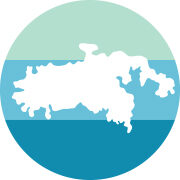
Hello everyone, and welcome to the middle of the week! Today, I want to share a little inside scoop with you. Some of the island’s most prolific trees are currently fruiting, and they’re providing an abundance of a delicious little treat!
For those of you who have been to St. John, you have probably noticed quite a few seagrape trees lining our beautiful beaches. The seagrape, whose botanical name is coccoloba uvifera, has broad, leathery round leaves with prominent red veins. These evergreen shrubs or small trees are an important species as they protect the island’s coastal areas from erosion and storm damage. The seagrape produces spikes of white flowers and then clusters of grape-like fruits. (Only the female trees produce fruit.)
I was out at Saltwell Bottom last week with island tour guests when Yola, one of the owners of the property, pointed out the fruiting trees beside the beach. “Get them now because they will be gone soon,” she told me. So I immediately did.
When the seagrape fruit is ripe, it turns reddish in color. And while it is not a true grape, people say it tastes similar to a muscadine grape. You can snack on this tasty little fruit, or use it to make jelly or wine. I don’t think it tastes like a supermarket grape per se, but it was an interesting little snack.


I also noticed a seagrape tree fruiting at Cinnamon Bay the other day. Specifically it was the tree outside of the main bathroom along the walkway to the beach.
If you’ve been on island following the 2017 storms, you likely have noticed small trees in little cages planted along the beaches inside of the National Park. A lot of these plants are serapes, and they are planted to restore some of the shoreline that was affected during Irma.

Pretty interesting stuff, right?
I was pretty excited to see these trees fruiting, and I hope you enjoyed this little story today. As always, if there is anything you are interested in learning more about, please feel free to send me an email at jenn@explorestj.com.
